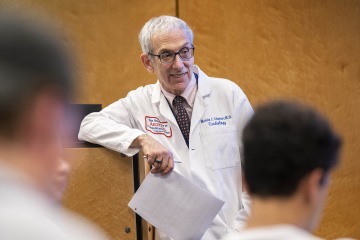Next-generation innovation
Marvin Slepian, MD, JD, is a truly a “triple threat” in his field: clinician, researcher and professor. When not seeing patients or advancing studies, he’s nurturing generations of future researchers to continue his legacy of impact in the gaps where it’s needed most.

Marvin Slepian, MD, JD, teaches a course in the University of Arizona Eller College of Management that helps students break down problems, learn how to find solutions and get real-world tools for entrepreneurship.
For over a decade, he’s taught a course he created for the University of Arizona Eller College of Management: Innovation, Translation & Entrepreneurship.
Mixing graduate and undergraduate students from many disciplines, the course explores drivers of innovation and the many dimensions of invention, new ventures and long-term vision – not in vague, high-level theory but in hands-on, rubber-meets-the-road application.
Students learn how to identify opportunities, dissect and break down problems, assemble necessary expertise for solutions and make hard choices around the real constraints of feasibility, resources, intellectual property, market forces, regulatory issues and potential impact.
In 2012, in response to a limited-submission call for proposals from the National Institutes of Health, Dr. Slepian envisioned and laid the initial planning for what became the university's Arizona Center for Accelerated Biomedical Innovation, where he serves as director.
Consistent with how Dr. Slepian engages the world, the center was created to fill a gap he identified in the innovation infrastructure. “You’ve got bright people doing great research,” he explains. “They’ve got the brainpower, but not necessarily the innovation mindset or training. And then you have a great tech transfer group like Tech Launch Arizona, but they don’t do the inventing.”
ACABI works as a missing link, identifying problems and bringing together brilliant minds to “churn” those problems against an inventory of extant science, including UArizona developed IP. Not surprisingly, its mission maintains and updates a list of 100 unmet medical needs as well as the science and technologies to potentially address them. With a track record of significant outcomes, university leadership is now working with Dr. Slepian to expand the ACABI model to drive innovation in fields beyond healthcare.
Through ACABI, Dr. Slepian also created an annual collective of a few dozen students from biomedical engineering, data science, physiology and medicine. They work on small-team projects while also bringing their diverse knowledge to bear on one full-group project, often focused on telehealth and the intersection of medicine and digital technologies. Their work regularly wins awards and earns top honors at conferences across the country.
“It’s an exciting time for students and the university,” Dr. Slepian said. “We need professors and students working beyond traditional departments. We need people not just thinking outside the box but doing things outside the box, handling things, working on real problems. This is where we need education to go.”

